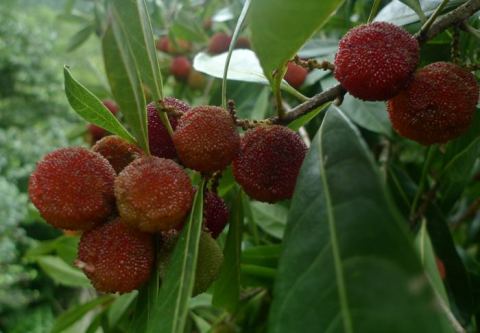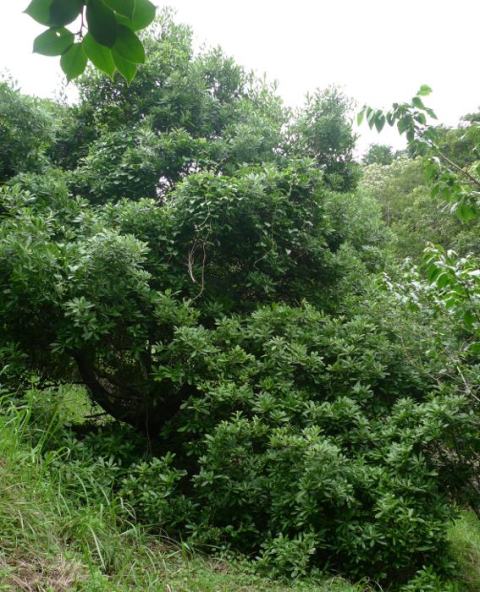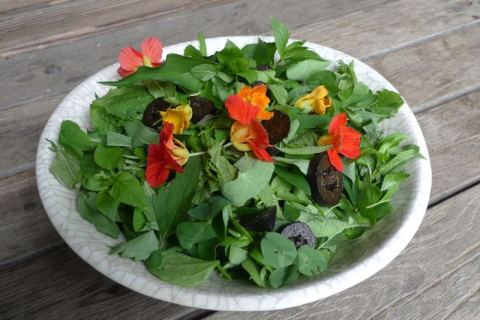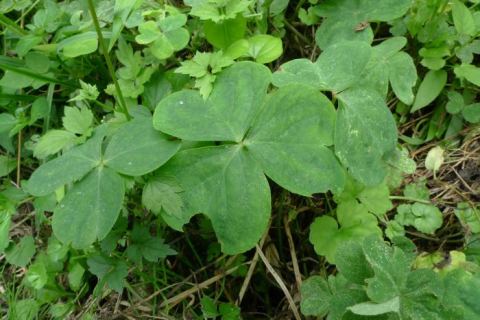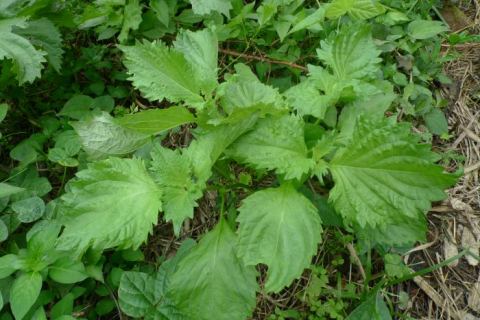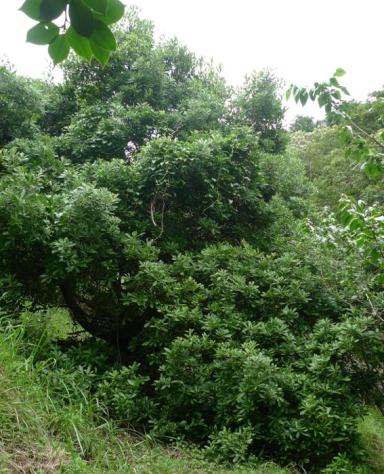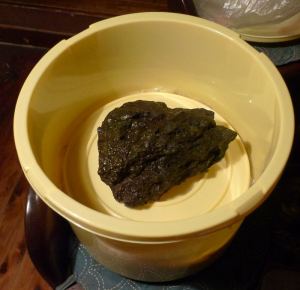Yamamomo
July 23, 2013
‘Tis the season for yamamomo (Myrica rubra), variously known to the English-speaking world as Chinese or Japanese bayberry, red bayberry, yumberry, Asian bog myrtle, Chinese strawberry tree or waxberry. Of these last two names the former comes from a resemblance to the strawberry tree (Arbutus unedo) and the latter because the fruit of other myrica species is coated in wax (from which candles can be made) and therefore they are known as wax myrtles or wax berries. However, despite sometimes being referred to as waxberry, the fruit of M. rubra does not have a waxy coating. A friend who lives without electricity (and thus always interested in potential sources of candle wax) has been wholly unsuccessful, despite her best attempts, in extracting any wax from M. rubra.
The Japanese name, yamamomo (山桃), means ‘mountain (yama 山) peach (momo 桃)’ although there is nothing very peach-like about the fruits of yamamomo. But then neither is there much peach-like about the native plums which are called sumomo (which once meant vinegar, or sour, (su 酸) peach (momo 桃)[1], although in contemporary Japanese sumomo is usually written 李 which obfuscates this older meaning). As far as I can see the only thing these other momo’s have in common with peaches is that they are round, stone fruits and usually red-ish.
The fruits of yamamomo are about 1.5 – 2 cm’s in diameter (there are cultivated varieties that have larger fruits however, according to local growers, the fruit is easily damaged by inclement weather at harvest time). The fruits grow in clusters and are dark red to purple when ripe. The tree is evergreen with leathery leaves and grey bark, reaching heights of 15 metres. It grows on forested mountain slopes (100 – 1500 metres) throughout southern China, Taiwan, Japan, Korea, the Philippines…[2]
The fruits are refreshingly tart and may be eaten fresh though often they are served in a sweet syrup. They also make wonderful wine (and if you can make wine you can, of course, make vinegar too). In both China and Japan they are used to make a medicinal liquor (steeped in báijiǔ in China and shōchū in Japan). See recipes below.
I have been told that, in the past, the seeds of yamamomo were also eaten in Japan. The seeds are “stones” like those of plums — although rather small they are very hard. I am yet to find out exactly how the seeds were rendered edible but I will surely update this post when I do.
The traditional medicinal uses of M. rubra by the peoples of east Asia include as an antidote for arsenic poisoning, a carminative, an anti-inflammatory, for the treatment of diarrhea, dysentery, dyspesia, nausea, excessive perspiration, psoriasis, and in the treatment of wounds, ulcers and sores.[3]
For the treatment of arsenic poisoning, wounds, sores and skin diseases a decoction of the stem bark is applied externally.[4]
The leaves have long been known to practitioners of Chinese medicine to be anti-inflammatory and recent studies have shown the juice of the fruits is also anti-inflammatory and effective in the treatment of ulcers.[5, 6]
_________________________________________________________________________________________________________
Yamamomo in syrup
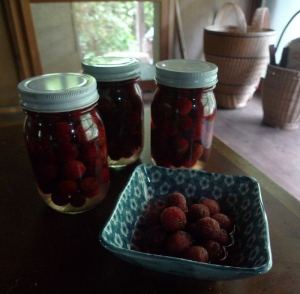 The few recipes for sweetened yamamomo that I have seen recommended cooking the fruit for 5 – 10 minutes in the syrup but I find this makes the fruit too mushy and it loses its wonderful tart edge. They also recommended an equal weight of sugar to that of the fruit – I say half that amount of sugar is plenty. I suspect these people don’t even like yamamomo!
The few recipes for sweetened yamamomo that I have seen recommended cooking the fruit for 5 – 10 minutes in the syrup but I find this makes the fruit too mushy and it loses its wonderful tart edge. They also recommended an equal weight of sugar to that of the fruit – I say half that amount of sugar is plenty. I suspect these people don’t even like yamamomo!
- Soak yamamomo in a salt brine for 30 minutes then rinse. This is to remove insects of which there are usually plenty.
- Bring sugar (half the weight of the fruit) to a boil in enough water to cover the fruit.
- Add the fruit and boil for just a couple of minutes.
- Put the fruit in jars and cover completely with the the syrup and screw on lids.
After about 24 hours they should be ready. Kept in a cool place they should keep for a month. If, once filled and capped, the jars are covered with hot water and boiled for 20 – 30 minutes the fruit should keep for up to a year. For more on processing for long term storage see here. I have attempted a batch with raw fruit — the yamamomo was not placed in the boiling syrup but directly in the jars and the hot syrup poured over the fruit — however, it started to ferment within a few days. Still tasted great though.
After finishing the fruit the syrup is used to make a very pleasant summer drink. Pour a little in the bottom of a glass and fill with cold water.
_________________________________________________________________________________________________________
Yamamomo Wine
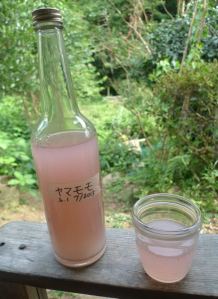 Yamamomo fruits are coated in wild yeasts which, if treated right, will happily make alcohol for you. And they’re so easy to please! Place the fruit in sugary water and stir often. As simple as that. How much sugar you use will affect the vigour and length of fermentation and thus the strength (alcohol content) of your brew. For a strong wine, use more. For 2kg of yamamomo I use about 1.25 kg’s of sugar. To make a simple “country wine” to be consumed “green”: [7]
Yamamomo fruits are coated in wild yeasts which, if treated right, will happily make alcohol for you. And they’re so easy to please! Place the fruit in sugary water and stir often. As simple as that. How much sugar you use will affect the vigour and length of fermentation and thus the strength (alcohol content) of your brew. For a strong wine, use more. For 2kg of yamamomo I use about 1.25 kg’s of sugar. To make a simple “country wine” to be consumed “green”: [7]
- Do not wash the yamamomo. You want to keep all the wild yeast on the fruit. Yes, there probably will be many tiny insects in the fruit but these will be strained out later. Place the fruit in the bottom of a container – a food grade plastic bucket or large glass jar will do nicely.
- Dissolve the sugar in enough cold water to generously cover the fruit (5 to 10 cm’s is good). Pour this mixture over the fruit in the bucket.
- Stir. And stir often. The more you can stir your potion the better. I stir my concoctions anywhere from 6 to 10 times a day. At a minimum give it at least four good stirrings every day.
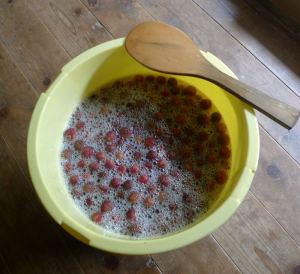
- Between stirring keep your bucket covered with a lid, cloth or anything else that keeps flies and dust out.
- After a day or two you should see bubbles or froth forming on the top of the liquid. Keep up the daily stirrings until the froth begins to lessen – hopefully this will take a couple of weeks.
- When fermentation does begin to subside strain in to bottles and enjoy.
_________________________________________________________________________________________________________
Yamamomo vinegar
Vinegar is essentially wine that has been overexposed to oxygen. Once the yeasts that converted the sugars to alcohol have begun to lose steam through lack of food acetobacter (acetic-acid-producing bacteria who were always present but until now held in check by the vigour of the yeasts) begin to dominate. It is acetobacter that will turn your wine in to vinegar.
So, to make vinegar follow the wine making steps listed above but rather than bottling the finished wine strain it into another wide mouthed container and keep covered with a cloth. Taste regularly and when it reaches the desired acidity (when it tastes like vinegar) bottle and cap. A vinegar ‘mother’ may have formed on top which you’ll need to remove before bottling. But don’t discard this. You can eat it, feed to it to your chickens or compost it.
_________________________________________________________________________________________________________
Yamamomo Koubo
Given that yamamomo is abundantly covered in wild yeasts (kõbo) it can also be used as a yeast source for bread (and probably beer too). Place some fruit in a jar, cover with water and add some honey or sugar. Stir or shake the jar often (if shaking release pressure by opening the lid after shaking). When it begins to bubble vigorously it is ready to use. For bread, just add some of the liquid to your dough mix. A little experimentation may be needed to get the amount right.
_________________________________________________________________________________________________________
Yamamomo shochu
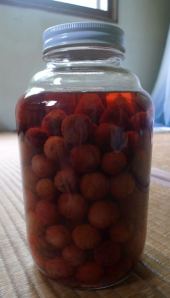 Simply steep yamamomo in liquor for a month or more. Here in Japan shōchū is typically used, in China it is báijiǔ and in Korea soju. These are all white liquors usually ranging from around 35 – 60% alcohol by volume. Vodka would be an obvious substitute. If you’re concerned about little insects in your alcohol soak the fruit in a salt brine for 30 minutes then rinse. Place the fruit in a jar and cover with liquor of your choice.
Simply steep yamamomo in liquor for a month or more. Here in Japan shōchū is typically used, in China it is báijiǔ and in Korea soju. These are all white liquors usually ranging from around 35 – 60% alcohol by volume. Vodka would be an obvious substitute. If you’re concerned about little insects in your alcohol soak the fruit in a salt brine for 30 minutes then rinse. Place the fruit in a jar and cover with liquor of your choice.
If your focus is on extracting the medicinal qualities of yamamomo then what you are making is a tincture. Fill your jar with as much fruit as possible before adding the liquor. Let it sit for at least one month and keep it out of direct sunlight. Shaking it around a bit from time to time is not a bad idea either.
If, on the other hand, you just want to flavour some liquor for drinking then less fruit/more liquor can be used.
______________________________________________________________________________________________________
References
1. https://ja.wikipedia.org/wiki/スモモ. Accessed 7/19/2013.
2. Flora of China Vol. 4. Available online at efloras.org. Accessed 7/20/2013.
3. Dr. Duke’s Phytochemical and Ethnobotanical Databases. Accessed 7/23/2013.
4. Plants for a Future, Myrica rubra. Accessed 7/23/2013.
5. Wang, S.J., et al., ‘Anti-inflammatory activity of myricetin isolated from Myrica rubra leaves.’ Planta Med 76(14), October 2010.
6. Alajmi et al., ‘Some pharmacological actions of Myrica rubra.’ African Journal of Pharmacy and Pharmacology Vol. 7(9), 8 March, 2013. PDF from Academicjournals.org. Accessed 7/23/2013.
7. For more on making country wines (or any other fermentation technique for that matter) see Sandor Katz, The Art of Fermentation. Chelsea Green, 2012.
An Affluence of Sleep
July 15, 2012
Month four in a twelve month journal of the wild foods we are eating. Previous posts in this series can be found here.
Roused from a midday sleep by hunger I grab a bowl, don a wide-brimmed straw hat and head out to gather a salad.
First I make my way to patches of ushihakobe (“cow chickweed”) and tsuyukusa (Asiatic dayflower), gathering generous quantities to bulk up the salad. Then on to chidomegusa (lawn pennyroyal) and tsubokusa (gotu kola), passing a nasturtium I pluck a few flowers and a handful of leaves, doing the same with shirotsumekusa (white clover). A few leaves of suiba (sorrel), a good handful of shiso leaves, shiroza (lambs quarters) and amaransasu (amaranth). Moving from the clearing where I have been gathering these sun loving plants I make my way toward the shady forest edge looking for sumire (violet). Passing oobako (plantain) sprouting new leaves I gather a bunch of the small tender light-green new growth (all the more tender for growing in dappled shade). After collecting sumire and katabami (wood sorrel) I investigate a patch of myoga – still a little early for the flowerbuds, I move on. Skirting the forest edge I pick young koakoso (nettle family) leaves then back in to the sun I gingerly take a few azami (thistle) leaves – these with prickly spines which I shall trim off with scissors later. Ambling back towards the house I gather some leaves of mint, nira (garlic chives), comfrey, mukuge (rose of sharon), lemon balm and lemon verbena, parsley and oregano.
Back inside, having trimmed the spines from azami, I toss everything in a bowl and top with kurumi (walnuts) pickled in a honey vinegar and dress with yamamomo (Chinese bayberry) vinegar.
A cup of suikazura (Japanese honeysuckle) flower tea in hand I return to horizontality and thumb through a book, recently read, looking for a passage in which an anthropologist suggests that one measure of a societies affluence might be the amount of daytime sleep afforded. Unable to locate the sentence I lay the book aside and go back to sleep.
———————————————————————————————
Koakoso (Boehmeria spicata) I mentioned a couple of months back as a pot herb. I was less than enthusiastic about the taste but I have found a new love for this plant as a salad green. The light green young leaves make a really nice addition to a salad – their mild flavour making them suitable for bulking up more pungent plants. Shadier locations will likely yield a greater quantity of the tender young things.
Ushihakobe (Stellaria aquatica) is a chickweed. It is not the chickweed (Stellaria media) but a closely related species that continues to grow vigorously through summer when hakobe (Stellaria media) is resting.
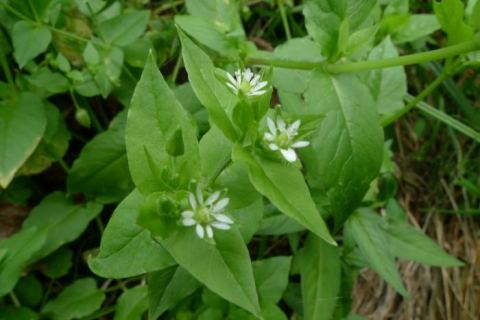 Ushihakobe (Stellaria aquatica)
Ushihakobe (Stellaria aquatica)
Mukuge (rose of sharon, Hibiscus syriacus) is a plant of Asian origin (but not of Syrian, as Linnaeus thought when he named the plant). It is a large deciduous shrub (up to 3m x 2m) with edible leaves, flowers and roots. I haven’t seen it growing wild here (yet – hopefully some of our fifteen or so plantings will be happy enough with their locations to go wild – it is a prolific producer of seed so chances are good) but it is a common ornamental plant and therefore one for you urban foragers to look out for. Also, as ours are still small I have so far only tried the leaves which I like a lot: mild flavoured with a pleasantly mucilaginous texture. There is a flowering specimen growing in a private garden in the village but, tempting as it is, I am well aware that every time I cycle through the village there is at least one set of eyes following me (“that strange foreigner who lives deep in the mountains”).
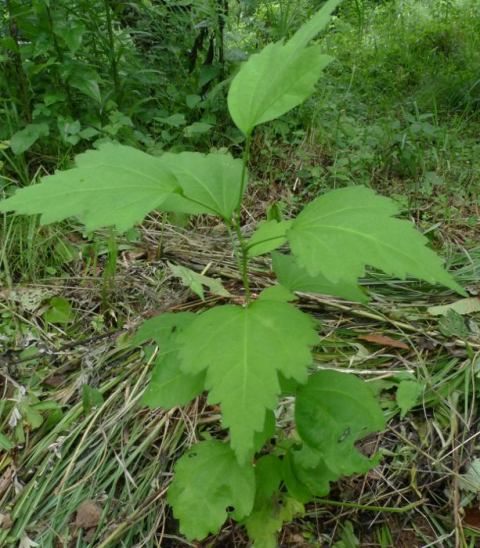 A mukuge (Hibiscus syriacus) sapling
A mukuge (Hibiscus syriacus) sapling
Katabami (Oxalis corniculata) is one of the many plants known to the English speaking world as wood-sorrel – their lemony tang being reminiscent of sorrel (Rumex spp.). The intense lemon flavour of oxalis and rumex species, while pleasantly refreshing and uplifting, is due to the presence of oxalic acids and a good indicator that moderation should be exercised. Large bowlfuls everyday are not the way to eat this plant. Some leaves mixed through a salad being more the way to go.
Shiso (Perilla frutescens) is, of course, the green leaf served as a garnish with sashimi and sushi (lately replaced by pieces of green plastic cut to vaguely resemble patches of grass). A really fantastic herb and all over the place! Don’t be timid with shiso. The flavour is mild enough to eat in quantity, it is nutritious and medicinal. Great as a salad leaf, or pickled in soy sauce and mirin, shiso pesto, shiso tea…. An annual that readily self-seeds to establish colonies and an excellent insectary plant, it’s a good candidate for scattering around in a forest garden, on abandoned land, city parks…. Green and purple varieties are common in Japan – the latter is not normally eaten fresh but is pickled and used in the making of umeboshi (pickled plums). Later in the year I’ll come back to shiso to talk about making use of the seeds.
Shiso‘s medicine: antiasthmatic, antibacterial, antipyretic, antiseptic, antispasmodic, antitussive, aromatic, carminative, diaphoretic, emollient, expectorant, pectoral, stomachic, tonic.
Shiroza (lambs quarters, fat hen, Chenopodium album) and amaransasu (amaranth, Amaranthus spp.) can be found growing wild throughout much of Japan. The young leaves of both are great in salads. Older leaves of shiroza can be boiled, steamed, added to soups etc. Both shiroza and amaransesu leaves are very nutritious. Both are weedy…let me rephrase that; both are important pioneer plants initiating processes of succession, thus enabling the return of forests – and so are also good candidates for seedballing barren sites or sunny openings of forest gardens.
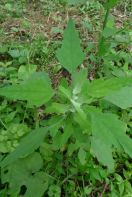
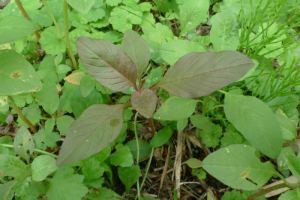
Left: shiroza (Chenopodium album) and right: amaransasu (Amaranthus spp.)
The dear old yamamomo (Myrica rubra) up the hill from our house has decided to give the fruit producing thing a miss this year but thankfully produced a good enough quantity last year for plentiful vinegar and wine making.
Yamamomo vinegar:
Mash up ripe fruit (the riper the better) and place in a well cleaned fermenting vessel (glass, ceramic, enamel coated metal but not uncoated metal as the acidity of the vinegar will eat in to it. My preference for cleaning such vessels is a strong antiseptic herbal tea such as sage, juniper, yarrow, kawakawa…). Dissolve sugar in water (about a quarter of a cup of sugar to 1 litre water. Use spring water if possible or, at least, water that has been boiled and let cool to around 40 degrees Celsius. The yeast on the skin of the yamamomo fruits, the beautiful microorganisms that are going to make this wonderful vinegar for you won’t appreciate it any hotter than that. Cover the fermenting vessel with a loose weave cloth and let sit stirring periodically (once a day is good). After about a week strain out the fruit and continue to ferment. After about a month the vinegar will be ready but leaving it for longer may mellow it out nicely. You can make vinegar from most fruit this way.
Finally this month is himekouzo (Broussonetia kazinoki), a somewhat scrappy looking tree/shrub with alluring berries which can be eaten raw and are very tasty but every so often one will irritate the tongue and roof of the mouth with a long lasting itchy sensation. The berries have long hairs which are likely responsible for this but it is a little strange that while all himekouzo berries have these hairs only some cause a reaction. There seems to be no way of telling before you put the berry in your mouth either. The sensation is unpleasant enough to likely put most people off playing Russian roulette with the raw berries but there are other ways to use them. I have tried cooking them in a tapioca pudding but ended up with a bowl of itchiness so they need more than just cursory cooking. Although I have not tried making a jam with them yet I suspect the cooking and mashing up of the berries in the process would take care of the problem. Likewise, ( and also so far untested), cooking, mashing and making fruit leathers. What does work is making himekouzochū, that is, soaking the berries in shōchū, vodka or the like. A good vinegar can be made from them also.
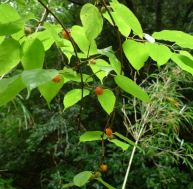
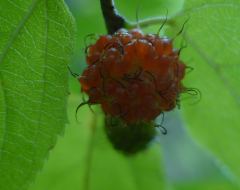
Himekouzo (Broussonetia kazinoki)
But the fruits are not the only edible part of this plant. The leaves are good cooked and the really young leaves can be eaten raw. The leaves do have a slight raspy texture but this is barely noticeable and nothing compared to the raspiness the berries can have. The flowers can also be eaten. Himekouzo is a close relative of kazhinoki (paper mulberry, Broussonetia papyrifera) and, like that plant, fibre from the bark can be used to make paper, cloth and rope.
Takenoko
April 26, 2011
This is a follow up on my bamboo shoot (takenoko) post from January. Back then I was writing about my experiences of harvesting shoots of around 15 centimetres in length and a few centimetres in diameter. Now we’re talking about takenoko like the one pictured below. Compare the matchstick at the base of the shoot for scale.
There are a few meals in this Moso (Phyllostachys edulis) shoot. Before offering some suggestions as to what you might do with one of these giants I want add a couple of points to what I have previously written about the precooking of bamboo.
As I have said previously some bamboos contain cyanide which can be leached by precooking in water containing nuka (rice bran). Usually we save the water from washing brown rice and use this to precook the shoots. If you do not have any bran available a chilli pepper placed in the water is also said to remove the cyanide. Boil the bamboo shoots in water containing nuka or a chilli pepper for anywhere from 30 minutes to one hour.
Research conducted in Japan and reported in the Journal of Biochemistry, Vol. 44, Issue 10, has found that bamboo also contains homogentisic acid. This “growth factor” in the bamboo shoot is probably responsible for lending the bamboo a taste, or more properly, a sensation of the mouth, known in Japan as egomi (which Asako translates as googey). This is a similar sensation to that experienced when eating raw taro. The precooking of bamboo as described above removes the egomi from the shoots.
In Japan it is said that bamboo cooked and eaten immediately after harvesting contains very little egomi and even less if harvested in the morning. When both criteria are fulfilled often the bamboo will be eaten without any precooking at all. I do not know if the absence of egomi also indicates an absence of cyanide but the practice of eating unleached bamboo shoots, harvested in the morning and eaten soon after, is an ancient one so probably quite safe. If in doubt ask the bamboo. If still in doubt play it safe and precook the shoots. The cyanide is not present in quantities that will kill you but if, like us, it becomes a seasonal staple leaching the shoots is a good idea.
Pictured below is Tsuchiya-san our wonderful mentor in the finer points of harvesting takenoko and all things related to foraging and mountain living. To get the best shoots they should be harvested when only a few centimetres of the shoot is visible above the ground. The soil from one side of the shoot is removed to the depth where the shoot joins the rhizome and the shoot is cut just above where the small roots emerge.
Takenoko steak
A great method of preparing fresh Moso (or other large) bamboo shoots that we were recently introduced to is as a ‘steak.’ For this you use the large ends of the shoots. After precooking slice rounds of the shoots a few centimetres thick, score the flat surfaces to absorb flavour and pan fry in a little oil or butter. Alternatively, marinate the steaks (shoyu and ginger, maybe) and grill.
Bamboo is a fast growing prolific plant so if you have access to a stand there should be no shortage of shoots for eating. The shoots begin sprouting in spring and may continue for a month or more depending on the species and location. If you have access to a bamboo species like Moso in a single shoot there will likely be more than one meal. Given these factors bamboo is a good wild food to preserve. While fresh food is usually better than preserved food preserved food is better than no food. And preserved bamboo shoots are probably still better than the ‘fresh’ supermarket fare produced by industrial agriculture. And, of course, fermentation is more than just preservation…
Salted and dried bamboo shoots
Precook the shoots in water containing bran or a chilli pepper for a minimum of 30 minutes. Remove the tough outer skin and cut the tender centre into strips. Cook again in water. Remove surface moisture from the cooked strips of shoot and sprinkle with a generous amount of salt. Over the following three days dry the strips of shoot in the sun and massage them as regularly as you can. When the strips are thoroughly dry (about three days) store in an airtight container. For use simply remove any excess salt and rehydrate (soak in water for 15 minutes or more) before cooking.
Fermented bamboo shoots
After precooking the shoots cut them into large pieces and layer them in a vessel (ceramic, enamel or food grade plastic) salting them generously. Place a lid of a smaller diameter than the fermenting vessel on top of the salted bamboo shoots and place a weight on top. The salt will draw moisture out of the shoots assisted by the weight which will also keep the the shoots submerged in this liquid. The shoots will ferment in this liquid and be preserved. For use wash off any excess salt and cook (or eat as is).
These preservation methods should keep the shoots until the next takenoko season rolls around and probably a lot longer. We’ll let you know next year just how well these methods work.
Update: April, 2012
The preservation techniques described above were successful! Here we are, foraging bamboo shoots once again and we still have some of last years preserved shoots in fine condition. This year we will try reducing the amount of salt we used in the second technique. We will also be experimenting with another technique using a combination of salt and okara (a by-product of tofu making). I shall let you know how that one goes.
Also we have learnt, from the old mountain folk and by experience that when the eating the fresh shoots within a day of harvesting, precooking is completely unnecessary.
